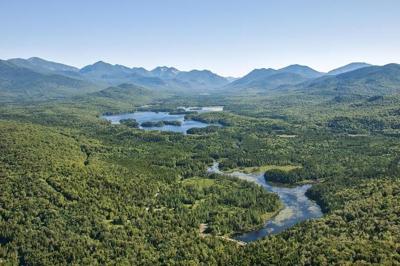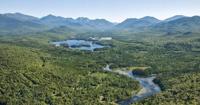ALBANY — The snowstorm that hit the region this past weekend throws a fresh wrench into a month of drastically fluctuating weather as spring arrives. With the solar eclipse now just two weeks away, forest rangers in the Adirondacks are warning visitors of unstable trails after one of the warmest winters on record.
Temperatures in the Capital Region have also recently reached upwards of 70 degrees, and will rise a bit again early in the week to melt away the most recent snowfall. However, Region 5 North Forest Ranger Captain Kevin Burns explained people forget that there is still three to four feet of snow at the higher elevations in the High Peaks.
“There's still a tremendous amount of snow up high and — like I said — down low, there's no snow, so people are of the mind, they're thinking, ‘Okay, it's time to go hiking,’” Burns said. “We still have that snowpack up high that creates those hazardous conditions.”
Burns said over the course of the winter, the traffic from people snowshoeing or skiing up a trail means the snowpack gets compacted and pressed in and becomes one solid form.
“And then when the warm temperatures come, the surrounding snowpack melts a lot quicker and then that trail becomes what we call a spine — it kind of melts slowly away and actually is like walking on a balance beam. There’s times where you're just kind of threading the needle, one foot in front of the other to stay on top of that trail system.”
Snowshoes are still required at the higher levels, he explained, because if a person does not have any on, they can punch through that snowpack and it can create a very dangerous situation with the potential to cause serious injuries in people’s lower legs.
The state Department of Environmental Conservation (DEC) has also issued advisories for would-be hikers and encouraged people to avoid all trails above 2,500 feet until conditions improve.
Burns said there is no set date that the trails will be safe to hike, as it depends on the weather.
“Some Aprils we have had the weather be in the 70s for three weeks straight, we're going to see that snowpack diminish quickly in those conditions. Or, it may rain for the first week of April, second part of April we’ll get a snowstorm. So, it's really hard to define when the trail conditions will improve over the course of the springtime,” Burns said. “It's all weather dependent and there's just no way for us to sit there and say, ‘Oh, yeah, April 21 everybody can hike, everythings going to be dry.’ There’s no way to really determine that.”
He added signs of spring have started, as he recently saw robins, which usually return early.
Meanwhile, state leaders are expecting an influx in visitors for the April 8 solar eclipse. The DEC has issued multiple advisories and created an interagency task force more than a year ago to prepare for the event. Leaders on the task force met in Albany on Monday to make New Yorkers aware of its preparations.
"We want to make sure you know where to watch, take the precautions and all the – we saw from the last experience many years ago that there were a lot of traffic jams and people running out of gas, and we're not going to let that happen in New York because we're New Yorkers and we'll be prepared," Gov. Kathy Hochul said on a livestream during the meeting.
Burns said rangers will conduct Preventative Search and Rescue Education (PSAR) for visitors at high-traffic trailheads.
“Kind of quiz them, like, ‘Are you capable of doing this? Are you really prepared to adventure up here and what happens if someone gets hurt?’ All the rangers in the North Country here in the High Peaks region — all the way up through to the Canadian border, we are focusing on trying to encounter as many people as possible,” Burns said.
All potential visitors are being warned to avoid the backcountry, where hiking trails can be rugged and rough and not maintained as frequently as park trails. Burns repeatedly stressed the need for preparation and education for visitors, especially those who may be unfamiliar with hiking in the Adirondacks outside the solar event.
“Then what we'll do is, after the event once the eclipse is over, with those folks who are possibly in the backcountry, they may be trying to exit the woods — we'll be ready,” he said. “If there's any emergencies, we'll be prepared to respond to any emergencies on state lands.”
Still, Burns said the eclipse will be a unique experience for many.
“It’s super rare and it’s going to be an amazing experience if we all can do this safely with the right weather,” Burns said. “The hotels [in the High Peaks] and the Tri-Lakes are full. They're up to 98% full, I think, with required three-night booking. So, we're looking at something very normal to a holiday weekend here in the High Peaks and then some. So, yes, we’re anticipating getting an influx of people and it could be challenging.”









